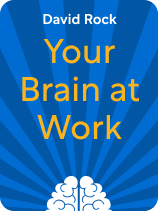

This article is an excerpt from the Shortform book guide to "Your Brain at Work" by David Rock. Shortform has the world's best summaries and analyses of books you should be reading.
Like this article? Sign up for a free trial here.
When you get stuck on a task, what do you do? How can understanding brain science help you get going again?
Regardless of the work you do, it involves some degree of creativity. That requires mental energy, and sometimes the energy just isn’t there. Business consultant David Rock explains the basics of what a mental block looks like and proposes three steps to reactivate your creativity.
Continue reading to learn how to overcome mental blocks by understanding how your brain works.
How to Overcome Mental Blocks
Creativity is a cognitive function that requires a significant amount of mental energy, and most jobs today require creativity to some degree. With technology advancing at an exponential rate, many workers must create solutions to problems that haven’t been seen before or invent new ways to distinguish their work from what’s already been done. When your brain doesn’t have an adequate amount of energy or loses focus, you can experience mental blocks. Rock offers advice on how to overcome mental blocks after explaining the science behind them.
| Too Much Creativity Can Be Counterproductive While innovation is an important part of business, some business experts warn against over-emphasizing creativity when hiring new employees. Conforming to company policies, like following repetitive procedures and completing mundane tasks, is necessary if employees are to contribute effectively to a company’s operations. When a company prioritizes creativity, it must allocate time for brain-storming (which may or may not produce tangible results), accept failures as part of the process, and enforce changes if the ideas are implemented—all practices that can be disruptive in the workplace. When it comes to hiring, experts of this philosophy suggest looking less for evidence of creativity and more for evidence of work ethic and follow-through. |
The Science
Creativity is the process of taking various networks in our brains and creating new combinations. Rock calls the new network insight and a mental block to finding new connections an impasse. An impasse can occur when the prefrontal cortex is low on energy or the limbic system is distracting you from going through your networks efficiently.
For example, imagine you’re trying to come up with a creative way to present your latest project, but the previous presentation didn’t go well. The memory of the unsuccessful presentation keeps popping up and distracts you from gaining insight into your new project. Additionally, in your anxious state, you forgot your lunch and haven’t been able to refuel from this morning’s tasks with glucose. According to Rock, you’re not going to be able to access your creativity unless you can work through this impasse.
| Break an Impasse With Hypnosis Preliminary studies suggest that hypnosis may help in breaking creative impasses, paving the way for insights. It may be that the deep state of relaxation refuels the brain and clears pathways for new neural connections to be formed. Hypnotherapy (therapy using hypnosis) is trending in some mental health circles, and some wellness experts encourage trying it for yourself by following a few simple steps: Start by setting your intention. As an example, if you’re at an impasse, you could state your goal as gaining insight into your specific problem. Open your mind to suggestion. To do this, close your eyes and engage with your other senses. For example, imagine each part of your body slowly winding down and relaxing. Think (or listen to a recording of) positive affirmations. Foster an optimistic state of mind by reinforcing positive qualities about yourself. For example, think, “I am creative,” or “I am intelligent.” Positive affirmations help clear any anxiety or insecurity around an issue and encourage your mind to welcome solutions. Visualize the results. Picture what it will be like once you come up with the answer. Will you be proud of yourself? Will you get a positive reaction at work? Having the image of your success helps your brain see the possibility as more concrete and accessible. Make hypnosis part of your routine. The more you practice, the easier the process will get and hopefully lead to more insights faster. |
How to Use the Science
Rock’s advice for finding a creative breakthrough is not to chase after inspiration but to methodically break the impasse.
The first step is to identify whether the source of the impasse is a lack of energy or an influx of away emotions.
- If the impasse stems from deficient energy, switch to a different, low-energy task, like going on a coffee run or completing an errand that is more routine. This will give your brain a chance to rest and recharge.
- If you’re feeling too overwhelmed by away emotions, let your mind go idle for a while with activities like meditation or doodling to clear your thoughts.
The second step is to reflect on your previous solutions. Ask yourself how you were coming to the solutions to your problems and see if you notice a pattern. Were you focused on just one aspect of the problem? Were you discussing the problem with the same people?
The final step is to try something outside of the pattern you’ve identified, and, once you have an idea, take immediate action. Your brain will experience a dopamine release from finding your creativity again, which is the best time to set your idea in motion. Additionally, by coming up with an idea, you’ll have a positive memory in your network for the next time you experience an impasse.
| How to Get Inspired Rock’s steps to find creativity apply to situations where you’re assigned a problem and struggle to find a solution. However, there are times when you must come up with both the problem and the solution, like when you’re looking for an idea for a new business endeavor or you want to invent a product. In these situations, some creatives believe that finding ways to spark insight may be the answer rather than focusing on overcoming impasses. Experts recommend the following tips for finding that spark: Take advantage of idle moments. There are times in the day when we’re just waiting, like waiting for food to reheat or standing in a long line. Many people would pass the time on their phones or otherwise try to escape the boredom, but these are the moments when your mind can rest. A relaxed brain is one primed for new ideas. Take time to play. Many activities we find fun also include an element of creative thinking. Creative play may beget more creativity. Additionally, playing should remove you from your office space, especially if it’s outside in nature. The change in scenery activates a dopamine release that may motivate creativity as well. Start small. It can be overwhelming to come up with a completely original idea. Instead, focus on how you can make an existing product or idea better, and you may realize new problems that you can provide the solution to. Persevere through failures. Creating something new often requires trial and error. Giving up after your first idea will dampen your motivation to be creative. Notably, even though these techniques are aimed at finding insight rather than overcoming impasses, they correspond in some ways to Rock’s advice on impasses. Allowing your brain to rest, for example, can not only spark insight, but it can also give you a chance to reflect on both the sources of your impasse and your previous solutions. And, taking time to play might help you come up with ideas outside of the patterns of solutions you’ve already tried, which can overcome your impasse as well as prompt new insight. |

———End of Preview———
Like what you just read? Read the rest of the world's best book summary and analysis of David Rock's "Your Brain at Work" at Shortform.
Here's what you'll find in our full Your Brain at Work summary:
- How leaders can generate productive work environments
- How to schedule your day around your brain's energy levels
- Three steps to reactivate your creativity after a creative block






